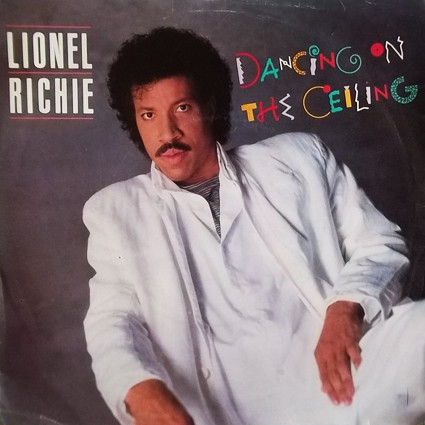Lionel Richie. The name itself might conjure up images of smooth ballads, white suits, and perhaps a slightly cheesy 80s aesthetic. For some, he’s an icon of a bygone era; for others, he’s a purveyor of overly sentimental tunes. It’s fair to say opinions on Lionel Richie are… varied. While some might readily admit to tuning into his greatest hits, others might change the radio station the moment they hear his unmistakable voice.
 Lionel Richie Dancing on the Ceiling music video still featuring 1980s fashion and a keytar
Lionel Richie Dancing on the Ceiling music video still featuring 1980s fashion and a keytar
However, even for the most staunch Richie skeptics, there’s often a surprising exception: “Dancing on the Ceiling.” Released in 1986 by Motown Records, this track stands out from Richie’s typical ballad-heavy discography. It’s an upbeat, energetic anthem that, against all odds, is undeniably catchy. It’s the kind of song that, when it pops up on a playlist, makes you pause before skipping. In fact, you might even find yourself turning up the volume.
The Unexpected Catchiness of “Dancing on the Ceiling”
What makes “Dancing on the Ceiling” so different? Firstly, it’s not another slow dance number. Instead of the maudlin melodies Richie is often known for, this song bursts with a perky, almost frenetic energy. The lyrics themselves are, frankly, a bit bizarre. “Dancing on the ceiling?” It evokes a sense of playful absurdity, a departure from the usual romantic themes. It’s the kind of concept that might emerge from a particularly vivid, perhaps slightly psychedelic, dream.
Musically, the song is a departure too. While it retains Richie’s smooth vocals, the instrumentation leans towards a more pop-rock sound, driven by a prominent drum machine and synth riffs typical of the mid-80s. It’s a far cry from the softer, more acoustic textures of hits like “Hello” or “Easy.” This sonic shift is arguably what gives “Dancing on the Ceiling” its unique appeal and enduring catchiness.
A Product of the 80s: Music Video and Cultural Context
The music video for “Dancing on the Ceiling” perfectly encapsulates the over-the-top spirit of the 1980s. Featuring vibrant colors, flamboyant fashion, and, crucially, a keytar, it’s a visual feast of 80s excess. Adding to the video’s quirky charm is a cameo appearance by comedian Rodney Dangerfield, who walks into the party scene, looks up at the ceiling dancers, and delivers the memorable line, “I shouldn’t have eaten that upside down cake!” This humorous touch further cements the song’s lighthearted and slightly surreal nature.
Released during the height of Richie’s solo career, “Dancing on the Ceiling” appeared on the album of the same name. Interestingly, while the album marked a commercial peak for Richie, it also signaled a shift in his chart dominance, arguably marking the beginning of a slow decline from his overwhelming popularity of the early to mid-80s. In a way, “Dancing on the Ceiling” can be seen as a final, exuberant hurrah of Richie’s reign as a pop music king.
Critical Reception and Enduring Legacy
Despite its undeniable catchiness and pop culture presence, “Dancing on the Ceiling” hasn’t always been a critical darling. Blender magazine, known for its provocative music criticism, even placed it at number 20 on their list of the 50 worst songs of all time. This placement highlights the polarizing nature of the song – what some find infectious, others find grating.
However, critical opinion isn’t universally negative. Robert Christgau, a highly respected and often discerning music critic, gave the Dancing on the Ceiling album a B+ grade. This positive assessment suggests that beneath the perceived schlock, there’s a level of musical merit that even serious critics could appreciate.
Regardless of critical debates, “Dancing on the Ceiling” has undeniably secured its place in pop culture. It remains a staple on 80s playlists and continues to be a crowd-pleaser at parties and events. The infectious melody, the call-and-response element of “Everybody clap your hands,” and even the slightly ridiculous premise of dancing on the ceiling contribute to its enduring appeal.
Beyond the Ceiling: The B-Side and Richie’s Broader Work
The B-side to “Dancing on the Ceiling” was “Love Will Find a Way.” While less discussed than its A-side counterpart, it offers an interesting contrast. Characterized by programmed drums and synthesizers, it’s a more typical Lionel Richie ballad, albeit somewhat unremarkable. In fact, its nondescript nature is almost part of its charm. In the context of Richie’s extensive catalog, “Love Will Find a Way” fades into the background, highlighting the unique energy and memorability of “Dancing on the Ceiling.”
Ultimately, while Lionel Richie’s discography might be a mixed bag for some, “Dancing on the Ceiling” stands out as a surprising gem. It’s a testament to the idea that even artists known for a particular style can occasionally break the mold and create something genuinely fun and infectious. So, the next time “Dancing on the Ceiling” comes on, resist the urge to skip it. Embrace the absurdity, clap your hands, and maybe even imagine yourself defying gravity and dancing on the ceiling. You might just find yourself enjoying it more than you expect.
